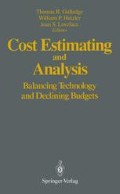Abstract
The study of estimation of the effort required for software development has progressed to the point where most currently used models employ an equation of the form y = ax°, which relates the effort to the lines of code, or size of a program, exponentially through a constant, e. That constant, e, the effort estimation exponent, has been referred to as an entropy constant by Randall Jensen1 and is the subject of many analyses, both theoretical and empirical, to estimate its value. In fact, many models indicate that its value is greater than one, meaning that the effort estimation curve bends upward, or that larger programs take proportionally more effort to develop. Yet, some estimates of the exponent’s value are less than one, and some SEL experience indicates a value of 0.92 and a curve that bends downward. This implies that larger programs take proportionally less effort to develop. Furthermore, if an exponent greater than one is employed, then the effort estimated to develop a large program will be greater than the sum of the effort required to develop each of its submodules individually.
Access this chapter
Tax calculation will be finalised at checkout
Purchases are for personal use only
Preview
Unable to display preview. Download preview PDF.
References
R. W. Jensen, “Sensitivity Analysis of the Jensen Software Model,” and “A Macro-Level Software Development Cost Estimation Methodology,” Fourteenth-Asilomar Conference on Circuits, Systems and Computers, IEEE, New York, 1981.
E. A. Nelson, “Management Handbook for the Estimation of Computer Programming Costs” AD-A648750, Systems Development Corp., Oct 31, 1966.
J. D. Aron, “Estimating Resources for Large Programming Systems,” NATO Science Committee, Rome, Italy, October 1969.
R. W. Wolverton, “The Cost of Developing Large-Scale Software,” IEEE Transactions on Computers, pp. 615–636, June 1974.
Doty Associates, Inc., “Software Cost Estimation Study, Guidelines for Improved Software Cost Estimating,” Volume II, RADC-TR-77–220, August 1977.
C. E. Walston and C. P. Felix, “A Method of Programming Measurement and Estimation,” IBM System Journal, 16, 1, 1977.
P. V. Norden, “Project Life Cycle Modeling: Background and Application of Life Cycle Curves,” Software Life Cycle Management Workshop. USACSC, Airlie, VA, August 1977.
L. H. Putnam, “Example of an Early Sizing, Cost, and Schedule Estimate for an Application Software System,” COMPSAC 1978. November 13–16, 1978.
B. W. Boehm, Software Engineering Economics. Prentice-Hall, Inc., Englewood Cliffs, NJ, 1981.
H. R. Barton, Jr., “Predicting Guaranty Support Using Learning Curves,” Proceedings of the Annual Reliability and Maintainability Symposium, IEEE, 1985.
J. T. Duane, “Learning Curve Approach to Reliability Monitoring,” IEEE Transactions on Aerospace, Vol. 2, No. 2, April 1964.
A. J. Albrecht and J. E. Gaffney, Jr., “Software Function, Lines of Code, and Development Effort Prediction: A Software Science Validation,” IEEE Transactions on Software Engineering, November 1983.
R. N. Foster, Innovation: The Attacker’s Advantage. Summit Books, New York, 1986.
“Proceedings of the Fifteenth Annual Software Engineering Workshop,” NASA/GSFC, Greenbelt, MD, November 1990.
Author information
Authors and Affiliations
Editor information
Editors and Affiliations
Rights and permissions
Copyright information
© 1992 Springer-Verlag New York, Inc.
About this paper
Cite this paper
Ayers, E. (1992). The Software Development Effort Estimation Exponent: An Effort Estimation Model Accounting for Learning and Integration. In: Gulledge, T.R., Hutzler, W.P., Lovelace, J.S. (eds) Cost Estimating and Analysis. Springer, New York, NY. https://doi.org/10.1007/978-1-4612-2936-0_4
Download citation
DOI: https://doi.org/10.1007/978-1-4612-2936-0_4
Publisher Name: Springer, New York, NY
Print ISBN: 978-1-4612-7727-9
Online ISBN: 978-1-4612-2936-0
eBook Packages: Springer Book Archive

